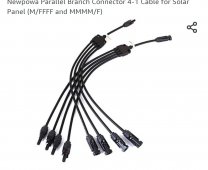Hey y'all ~ I'm losing my mind trying to figure out whether a purely parallel or series-parallel config is the best way to go for my setup. It's a 21ft Travel Trailer; planning to use only solar + off-shore option with the possibility of alternator charging via tow vehicle later on. I've been doing tons of research over the past few weeks and piecing everything together for my needs. I could really use some advice on this specific question...
I have a 24V/300Ah battery bank, a victron 100V/50A mppt charge controller, and [4] 200W/"24V"/8.33A rich solar panels. the benefits of using less equipment in series-parallel are enticing, but would series-parallel result in the voltage being too close to the 100V allowance of the charge controller? any guidance is much appreciated! Thanks again!
I have a 24V/300Ah battery bank, a victron 100V/50A mppt charge controller, and [4] 200W/"24V"/8.33A rich solar panels. the benefits of using less equipment in series-parallel are enticing, but would series-parallel result in the voltage being too close to the 100V allowance of the charge controller? any guidance is much appreciated! Thanks again!



